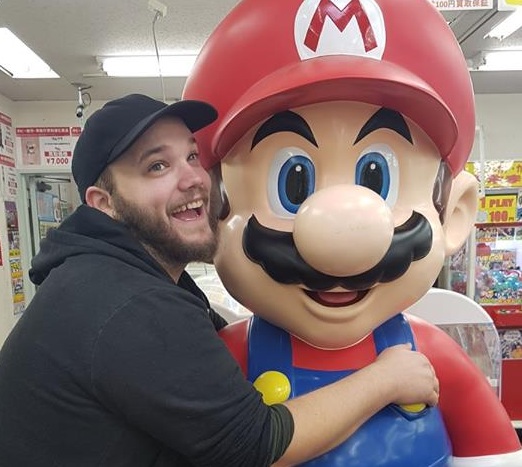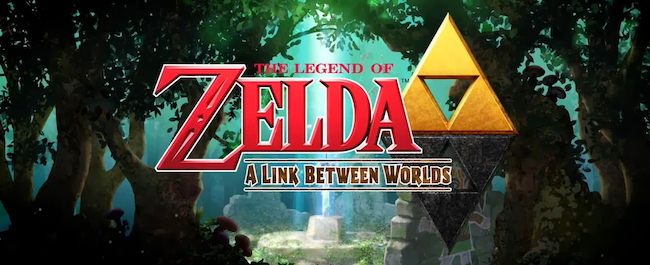
The Legend of Zelda: A Link Between Worlds is a spiritual successor, and indirect sequel, to the 1991 SNES title, A Link to the Past. Launching at the same time as Super Mario 3D World, both titles released to much critical acclaim. However, both of these titles also bring full circle to an adopted practice that Nintendo’s first party titles usually follow; continuously revisiting old games and franchises, in an attempt to conceptualise minor design revisions, and capitalise on nostalgia. Speaking honestly, Super Mario 3D World has very little innovation for a Mario game, and yet, the design of A Link Between Worlds genuinely feels somewhat different. And oddly, both games reach their respective conclusions by basically using the same methods. There is a popular joke that Nintendo just re-package our childhood to sell back to us as new games, and in truth, this joke is starting to become a little too literal. However, in saying that, it’s not only true of Nintendo, with remakes, and re-re-rebooted re-releases being hurled at us by an industry that seems to have only just cottoned onto the “nostalgia” paradigm.
Naturally, this process applies to A Link Between Worlds as it not only follows many trends set by its spiritual predecessor, but was originally intended to be a straight up remake of the SNES game. However, Nintendo changed their minds part way through pre-production, and chose to develop a separate game within it’s own right; instead, only taking design influences from A Link To The Past. In truth, these influences are so thoroughly ingrained in the narrative that it occasionally feels as if they’ve just slapped a 3D veneer over the early 90′s title hoping we wouldn’t notice. Interestingly, this doesn’t make it a bad game, in fact, A Link Between Worlds is actually one of my favorite games of last year. By some bizarre paradox of reason, it’s because of this familiarity that it works so well. The difference between this and every other “remake” that goes rooting through our childhood memories is that, exempting the main narrative, it makes sense to do so, even going so far as to leave in the fun.
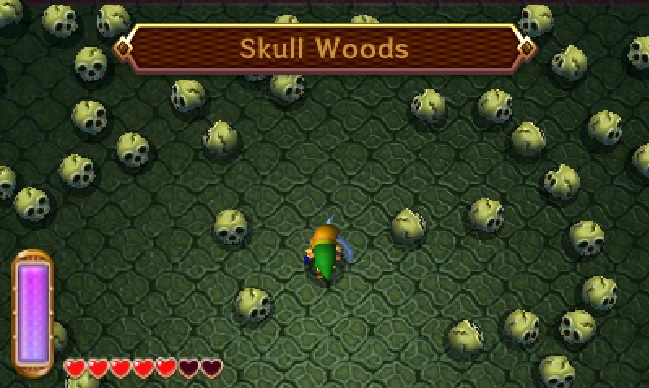
A Link Between Worlds borrows so heavily from A Link to the Past that the same plot description could have easily applied to either game. Darkness befalls the land and Zelda asks Link to take care of it. Zelda ends up being captured, and Link must prove himself worthy of the Master Sword. With that sword, Link must rescue the Seven Sages in order to defeat the darkness, and during all of these events, Link will travel back and forth between his own reality, and a darker version of the world. For longtime fans, such as myself, the narrative is so familiar that without playing the game, I likely could have told you how the story concluded. Sure, the “Dark World” is called Lorule now, with Nintendo insisting that the two are different places, and the Seven Sages are technically different people, with it being Yuga instead of Agahnim. However, all the basics are there. This is because Zelda games always revisit the same mythos, and in turn, find new and entertaining ways to re-tell the same story. Doing it for 20 years is a pretty ballsy business move by Nintendo, but it’s not hard to see why, given the series success.
This doesn’t mean that the story of A Link Between Worlds isn’t good, just that by this point, it should be called a homage to a classic at worst, or the literal embodiment of the stereotypical Zelda story arc at best. It wraps things up without any loose ends, and if you were to suspend absolutely any brain activity towards the end, there might even be a little twist in there for you. Despite each of the Zelda games having a somewhat repetitive nature with narrative, they usually provide something new and interesting among the familiarity which anchors the player to the game world. Disappointingly, the changes made to the over-arching narrative of the timeline don’t make any significant impact as either a cause for future events, or as a portrayal of past events from earlier in the timeline.
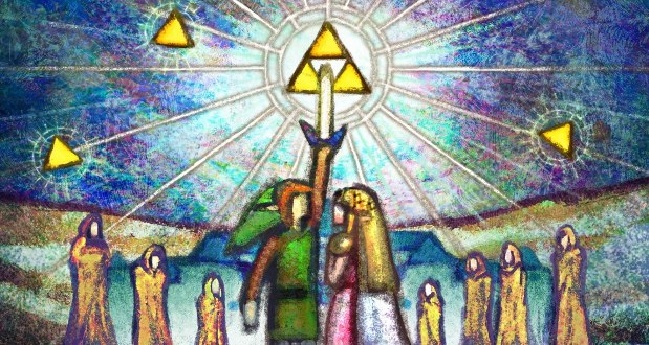
A Link Between Worlds doesn’t have a bad story. It has a good story that’s been done before, and it fulfills it’s purpose admirably by allowing the game to progress, as well as providing context those events. It also provides the player with enough motivation to keep going. Despite delivering what is vaguely the same story for a couple of decades, people are still hoping that Nintendo will change things up. Here’s a quick “spoiler”: They probably never will. However, to say that the narrative is anything other than a revised version of A Link To The Past would be an outright lie, and it kind of makes me wonder why they didn’t just stick to their original idea of a remake.
Exploration has always been a big theme in the Zelda franchise, and one of the draw-cards in building player interest. The traditionally linear nature of previous Zelda games tended to place a pretty tight restriction on where you could go, and when you could go there. Whether it’s the dungeons and temples, or the world that the game takes place in, you could take a look around. However, there’s always been a particular order to how you do it, and that was just the way it was. A Link Between Worlds has addressed this issue, somewhat, by venturing into the realm of open world design, and putting no obstacles in the way of the player choosing which area, dungeon or temple they would like to explore first. It’s a welcome and refreshing change to the Zelda routine, reviving the same sense of wonder, through exploration that many gamers would have had while playing A Link To The Past.
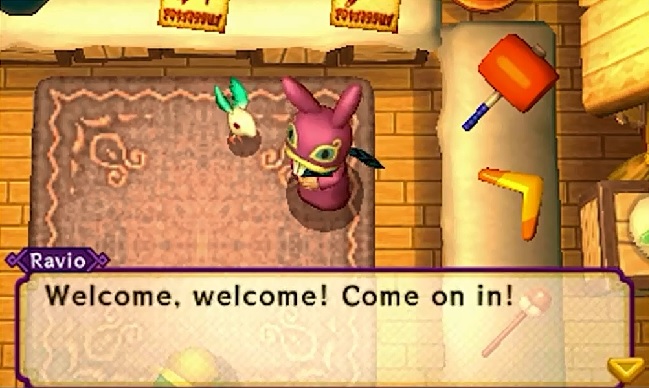
The ease of exploration in the game is also partly driven by the overhauled item system, which practically hands you almost everything there is to possess right from the beginning (albeit, in “weaker” versions). Items are now available for “rent” (and later purchase), and you can hire everything at once if you truly wish, with the items being retrieved by the shop keepers bird upon your untimely death. The morality of robbing a corpse aside, this change means the way that puzzles and combat are handled is no longer dictated by whichever item you picked up most recently. Instead, you now have to approach everything like it’s the end-game section of every other Zelda title because every challenge becomes a riddle that asks, “Which of the items in your arsenal is the key to victory?”. Essentially, Players can no longer rely on answers that are pretty much belched out by the last chest they opened.
However, with new changes come new problems, and there are some kinks that weren’t quite worked out before the game was released. Upgrades to weapons, armor and other items are still available in the game, usually hidden in the dungeons, but the non-linear nature of the game means you could find them pretty early on, or not until you’ve nearly finished the game. During my playthrough, I found the armor and sword upgrades fairly early, but I didn’t find the item power meter upgrade until close to the end of the game which kept my combat almost strictly melee until the final few stages. Having every item from the start can be handy, but there’s no way to tell which one you’ll need before getting to each dungeon, which means either an awful lot of backtracking, or a lot of grinding for rupees if you happen to be the kind of adventurer who frequently drops dead. However, in saying that, it does mean that rupees have actually become useful now, which has been an issue with previous games.
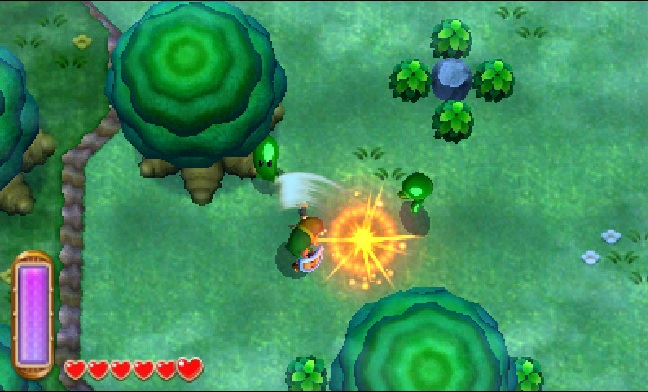
As with most Nintendo games, Zelda performs near-flawlessly, with the flow of the gameplay being aided by controls as responsive as Pavlov’s dog. Everything from combat to movement works as advertised and this extends to the Merge ability; a wild card ability akin to the Ocarina, Wind-Waker, or Gigantic Cross-Continent Train. It’s clear that a lot of care was taken with this aspect of the game since I can’t recall a single moment where I was ready to fling the console across the room in frustration. In fact, the experience of playing the game is one of the most cathartic and enjoyable experiences I’ve had in quite some time (with a videogame), and it’s mostly because Link actually attacks when you press the attack button, instead of flinging himself into the nearest wall.
If one gripe could be taken up with the way that the game handles, it’s the camera angles during Links use of the Merge ability. Whether by fault or design, every time the camera angle changes to face Link in his new 2D form, it also has a tendency to zoom in so far that you end up missing a lot of other detail around the place. It can become very frustrating, especially during puzzle sequences when you’d like to have a bit more perspective on your surroundings. However, in saying that, this could be the point, and that’s something that I couldn’t quite work out. Eventually, I adjusted, and learned to extend my memory beyond that of your average goldfish so that these moments would stop tripping me us because they happen frequently. Although, even this wouldn’t be enough to detract from the otherwise enjoyable experience that A Link Between Worlds provides through play.
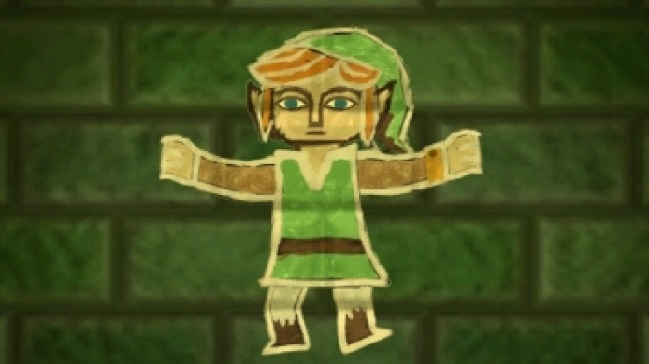
I’ve said before, and it can’t be denied that Nintendo games are still setting a standard for visual appeal, and doing so without having photo-realistic graphics. The Zelda series has changed it’s style and appearance many times over the years, with particular groups of games following their own particular trends while others stand out just on their own. The Legend of Zelda and The Legend of Zelda II: The Adventure of Link are both very distinct, whereas Windwaker, Minnish Cap, Spirit Tracks and several others all share the same art style. Interestingly, A Link Between Worlds is an unusual hybrid of the two, taking the animations and art styles from The Legend of Zelda and A Link to the Past, both 2D worlds, and bringing it into a 3D environment with its own unique appearance that hasn’t been seen quite this way in a Zelda game before. Apparently, it looks like this if you change the angle.
Surprisingly, the 3D aspect of the game does actually look pretty neat since a lot of the enemies jump or bounce around, and a lot of the puzzles that you encounter involve multiple levels (height) in a room. The 3D effects of the handheld really aid the animation when falling from platforms, or interacting with the environment around you. In fact, it genuinely feels as if this was something that the visual design team had in mind from the beginning. Unfortunately, as with all games on the 3DS, the 3D function really can’t be used for too long. Personally, I am pretty prone to headaches, and my eyes are pretty messed up as it is, so having it on for any longer than a few minutes at a time practically burns my eyes right out of their sockets. Although, with that being said, more physically fit people i’ve spoken with have also reported the same problems, even on a low setting. So, unless your a mutant, the 3D function is pretty, but not hugely practical, and can potentially be damaging to ones eyes.
 A conclusive well rounded story
A conclusive well rounded story Allowance for “open world” exploration
Allowance for “open world” exploration Engaging gameplay mechanics
Engaging gameplay mechanics More freedom with item use
More freedom with item use Interesting hyrbid of visual designs
Interesting hyrbid of visual designs
 Many design elements were “borrowed”
Many design elements were “borrowed” The plot is more “recycled” than ever
The plot is more “recycled” than ever 3D features are good but impractical
3D features are good but impractical Occasional “grinding” will be necessary
Occasional “grinding” will be necessary
A Link Between Worlds isn’t the most inspired game in the Zelda franchise, or even of last year. However, in saying that, it certainly charmed its way into my personal list of favored titles by simply being good at what it does. That’s not something that too many games can say these days since many of the “AAA” titles that have GOTY awards flowing out of their ears, usually have a laundry list of mechanical, narrative, and design flaws. This game knows what it is, plays to those strengths, and makes no attempts to “spread itself out” into other styles of gameplay or genres. Essentially, unless you’re not a fan of classic hack’n’slash adventure titles then the game should never never overstay it’s welcome. Above all else, it still manages to accomplish some level of innovation by changing up the conventional Zelda design, and one can only hope that this is a good sign for what’s to come!

